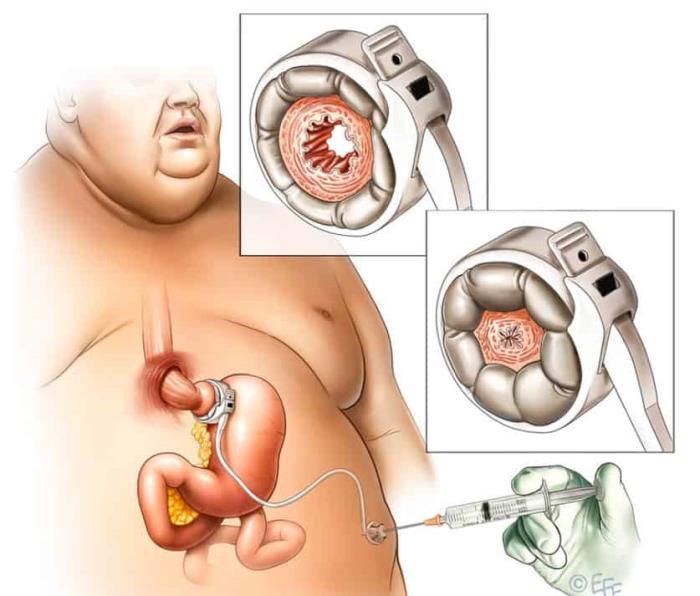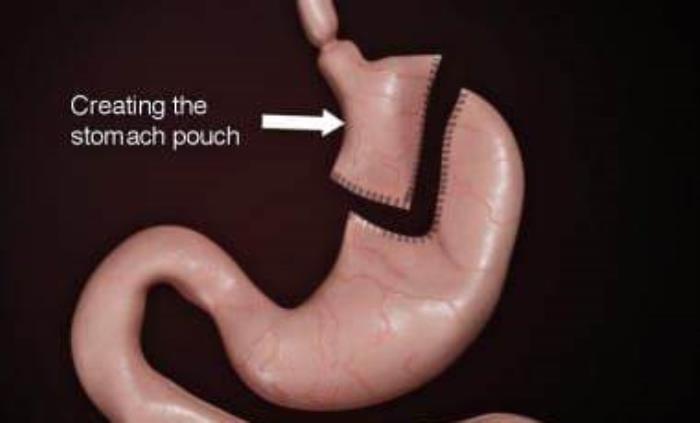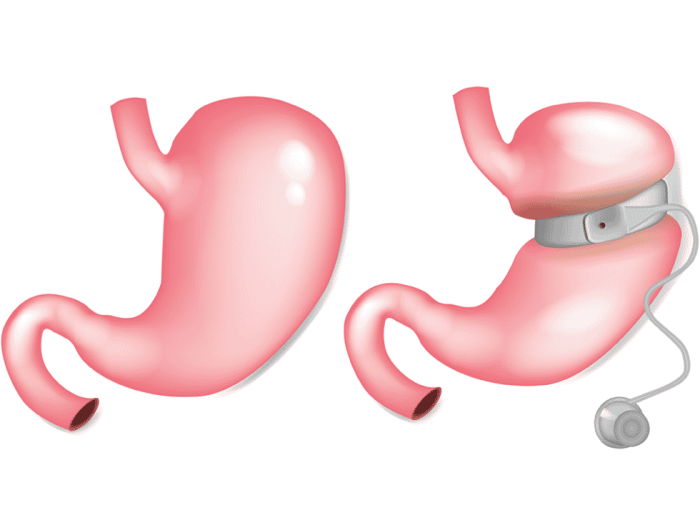Gastric banding is a minimally invasive weight loss surgery that involves placing an adjustable band around the upper portion of the stomach. This procedure is designed to help individuals struggling with obesity achieve significant weight loss by limiting food intake and promoting a feeling of fullness with smaller meals. Understanding the gastric band procedure is essential for potential candidates, as it outlines the mechanisms through which this surgery can lead to healthier lifestyles and improved overall health.
The gastric banding approach is particularly appealing due to its adjustable nature and reversible characteristics, making it a popular choice among patients seeking effective weight loss solutions.
What is a Gastric Band and How is it Used?
A gastric band is a silicone device that is surgically placed around the upper part of the stomach, creating a small pouch. This pouch significantly reduces the stomach's capacity, allowing the patient to feel satisfied with much smaller portions of food. The band can be adjusted via a port placed under the skin, allowing for tailored adjustments based on the patient’s individual weight loss progress and dietary needs.
The primary purpose of the gastric band is to aid in weight loss by promoting portion control and reducing hunger, thereby helping patients develop healthier eating habits and achieve long-term weight management.
The Laparoscopic Adjustable Gastric Banding (LAGB) Procedure Explained
The Laparoscopic Adjustable Gastric Banding (LAGB) procedure is performed using minimally invasive techniques, which means smaller incisions and reduced recovery times compared to traditional open surgery. During the procedure, the surgeon places the gastric band around the upper stomach and connects it to a small port that sits beneath the skin.

This approach allows for easy adjustments of the band’s tightness, which can be done in outpatient settings. Patients typically experience less postoperative pain and a quicker return to normal activities, making LAGB a favorable option for those seeking weight loss surgery.
How the Gastric Band Restricts Food Intake
The gastric band restricts food intake by creating a small stomach pouch that limits the amount of food the patient can consume at one time. As the pouch fills up quickly, it sends signals to the brain indicating fullness, which helps reduce overall food consumption. This mechanism not only assists in weight loss but also encourages patients to adopt healthier eating habits by focusing on portion control.
Patients are generally advised to eat slowly and chew their food thoroughly, further enhancing the band’s effectiveness in promoting satiety with smaller meals.
The Role of the Stomach Pouch in Limiting Food Consumption
The stomach pouch created by the gastric band plays a crucial role in limiting food consumption. This small pouch has a reduced capacity, typically holding only a few ounces of food, which means patients feel full sooner than they would with a normal-sized stomach. The pouch’s design ensures that patients can still enjoy a variety of foods, but in significantly smaller portions.

Additionally, the pouch promotes a shift in dietary patterns, encouraging patients to choose nutrient-dense foods over empty calories. This change in eating behavior is vital for achieving and maintaining weight loss and overall health post-surgery.
Adjustable Feature: How the Band is Tightened or Loosened
The adjustable gastric band system includes an inflatable band placed around the upper portion of the stomach. This band can be tightened or loosened through a port located under the skin, which connects to the band via a thin tube. Adjustments are typically made during follow-up appointments, allowing for personalized control over the band’s tightness. Tightening the band reduces the stomach's capacity, promoting a feeling of fullness with smaller meals, while loosening it can help alleviate discomfort and ensure adequate nutrient intake.
How the Gastric Band Helps in Achieving Weight Loss
The gastric band aids in weight loss primarily by limiting food intake. By creating a smaller stomach pouch, it helps patients feel full sooner and reduces the amount of food they can consume at one time. This physiological change encourages smaller portion sizes and can lead to a significant decrease in overall calorie intake. Additionally, the band can help promote healthier eating habits as patients learn to choose more nutritious foods that align with their new lifestyle.

Appetite Control: How the Band Affects Hunger Signals
The gastric band influences appetite control by altering the signals sent from the stomach to the brain. When the band is properly adjusted, it can slow down the passage of food into the stomach, prolonging the feeling of fullness and reducing hunger cues. This delay in food processing helps regulate appetite, making it easier for individuals to avoid overeating and manage their dietary intake, ultimately contributing to sustained weight loss.
The Importance of Portion Control with a Gastric Band
Portion control is a critical aspect of successfully using a gastric band for weight loss. Patients are encouraged to adopt smaller meal portions, which aligns with the reduced stomach capacity created by the band. Learning to recognize appropriate serving sizes helps prevent overeating and maximizes the effectiveness of the procedure. Over time, this practice fosters healthier eating habits that can lead to long-term weight management and improved health outcomes.

Customizing the Gastric Band for Individual Needs
Every patient’s needs are different, which is why the gastric band can be customized through adjustments made by a healthcare provider. These adjustments allow for changes in how tight or loose the band is, tailoring the treatment to individual weight loss goals, lifestyle, and tolerance. Regular follow-up appointments are essential to monitor progress and make necessary adjustments, ensuring the band remains effective throughout the weight loss journey.
Who is an Ideal Candidate for Gastric Band Surgery?
Ideal candidates for gastric band surgery typically include individuals with a body mass index (BMI) of 30 or higher, who have struggled with obesity-related health issues and have not achieved sustainable weight loss through diet and exercise alone. Candidates should be willing to commit to a healthy lifestyle, including dietary changes and regular physical activity, and must have realistic expectations regarding weight loss outcomes. A thorough medical evaluation is essential to determine candidacy and ensure the procedure aligns with the patient’s health goals.
Understanding the Follow-Up Care and Adjustments Required
Follow-up care is crucial for individuals with a gastric band. Patients usually have regular appointments to monitor progress, assess the band’s effectiveness, and make necessary adjustments to ensure optimal results. These follow-ups allow healthcare providers to modify the band’s tightness based on the patient’s weight loss progress, appetite changes, and any potential complications. Ongoing support is vital for achieving long-term success and maintaining a healthy lifestyle after surgery.
How Long Does it Take to See Results with a Gastric Band?
Patients can expect to see noticeable weight loss results within the first few months following gastric band surgery. Many individuals experience an initial significant weight drop within the first six months, with gradual, continued weight loss occurring over the following year or more. However, results can vary based on individual factors such as adherence to dietary guidelines, exercise routines, and the band’s adjustments. Regular follow-up appointments play a key role in optimizing outcomes and supporting sustained weight loss.
The Role of Diet and Exercise Alongside the Gastric Band
A balanced diet and regular exercise are essential components of a successful weight loss journey with a gastric band. Patients are encouraged to follow a nutritious, portion-controlled diet that emphasizes whole foods and limits high-calorie, low-nutrient items. Exercise enhances weight loss efforts, promotes overall health, and helps maintain muscle mass during weight loss. A comprehensive approach that includes dietary changes and physical activity can maximize the benefits of the gastric band and support long-term success.
Potential Complications: What to Watch Out For
While gastric band surgery is generally safe, there are potential complications that patients should be aware of. These include band slippage, erosion, or infection, which can lead to discomfort and may require additional medical intervention. Patients may also experience nausea, vomiting, or difficulty swallowing if the band is too tight. Regular follow-up appointments and open communication with healthcare providers are essential to identify and address any complications early, ensuring a successful outcome and minimizing risks.
How the Gastric Band Differs from Other Bariatric Procedures
The gastric band differs from other bariatric procedures, such as gastric bypass and sleeve gastrectomy, primarily in its mechanism and invasiveness. The gastric band is a minimally invasive procedure that involves placing an adjustable band around the upper portion of the stomach, creating a small pouch. This limits food intake and promotes a feeling of fullness. In contrast, gastric bypass and sleeve gastrectomy involve surgical alterations to the stomach and digestive tract that not only limit intake but also reduce nutrient absorption. As a result, the gastric band offers a less invasive option with the ability to adjust its tightness, while the other procedures often lead to more significant, immediate weight loss.
Can the Gastric Band Be Reversed or Removed?
Yes, the gastric band can be reversed or removed if necessary. Unlike more invasive bariatric surgeries, the gastric band is designed to be adjustable and removable. If a patient experiences complications, does not achieve the desired weight loss, or wishes to discontinue the treatment, a healthcare provider can perform a minimally invasive procedure to remove the band. This flexibility allows patients to explore other weight loss options or revert to their original anatomy if their health needs change.
Patient Testimonials: Real-Life Experiences with Gastric Bands
Many patients have shared positive experiences after undergoing gastric band surgery, noting significant weight loss and improved health outcomes. Testimonials often highlight the gradual, sustainable weight loss achieved with the band, as well as enhanced energy levels and improved self-esteem. Patients appreciate the adjustable nature of the band, which allows for personalized adjustments as their weight loss progresses. However, some also emphasize the importance of commitment to lifestyle changes, such as diet and exercise, to maximize the benefits of the procedure and maintain long-term success.
Long-Term Success with the Gastric Band: Tips and Insights
Long-term success with a gastric band largely depends on adherence to dietary guidelines and a commitment to regular physical activity. Patients are encouraged to eat small, nutrient-dense meals and avoid high-calorie, low-nutrient foods. Keeping a food diary can help track intake and identify patterns. Regular follow-up appointments for adjustments and support are also essential for maintaining motivation and ensuring the band functions effectively. Additionally, building a support network, whether through family, friends, or support groups, can provide encouragement and accountability on the weight loss journey.
Conclusion: Is the Gastric Band Right for You?
Determining if the gastric band is the right choice involves evaluating individual health needs, weight loss goals, and lifestyle changes. It is suitable for individuals with a BMI of 30 or higher who have struggled with obesity-related health issues. Patients should be prepared to commit to a healthier lifestyle, including dietary modifications and exercise, to maximize the band’s effectiveness. Consulting with a qualified healthcare provider can help assess candidacy and provide personalized recommendations, ensuring that the decision aligns with the patient’s overall health objectives.
Best LAGB Surgery in India
The Best LAGB Surgery in India helps patients manage obesity by placing an adjustable band around the stomach, limiting food intake and promoting gradual weight loss.
Best LAGB Hospitals in India
The Best LAGB Hospitals in India offer top-notch facilities with experienced surgical teams, providing personalized care and support throughout the patient's weight loss journey.
LAGB Surgery Cost in India
The LAGB Surgery Cost in India is affordable, offering transparent pricing and accessible treatment options while maintaining high standards of care at leading hospitals.
Best LAGB Surgeons in India
The Best LAGB Surgeons in India are highly skilled and experienced, ensuring precise surgical techniques and personalized care for optimal weight loss outcomes.
FAQ
How does the gastric band help with weight loss?
The gastric band promotes weight loss by creating a smaller stomach pouch, which limits food intake and enhances the feeling of fullness. This reduces overall calorie consumption and encourages healthier eating habits.
How is the gastric band adjusted?
The gastric band is adjusted by adding or removing saline through a port placed under the skin. This allows healthcare providers to tighten or loosen the band to optimize its effectiveness based on the patient's progress and comfort level.
How much weight can I expect to lose with a gastric band?
Patients can typically expect to lose 30-50% of their excess weight within the first 1-2 years after surgery, though individual results vary based on factors such as adherence to dietary recommendations and exercise.
Can the gastric band be removed after I reach my goal weight?
Yes, the gastric band can be removed if the patient wishes to discontinue its use, particularly after achieving their weight loss goals or if complications arise.
What lifestyle changes are needed after gastric band surgery?
Post-surgery, patients need to commit to a healthier lifestyle, which includes adopting a balanced diet with smaller portion sizes, regular physical activity, and attending follow-up appointments for adjustments and support.